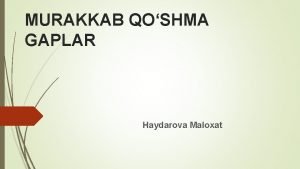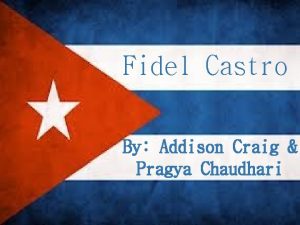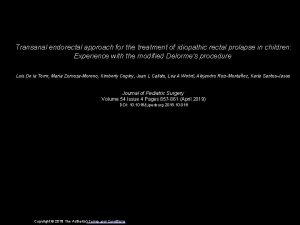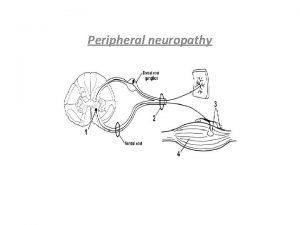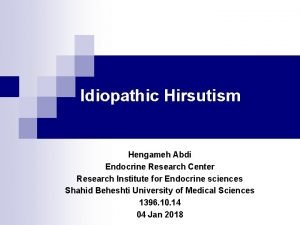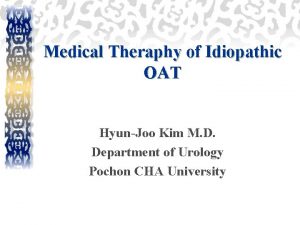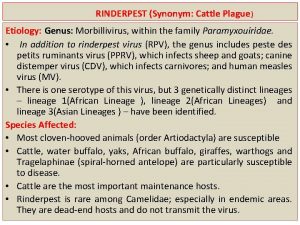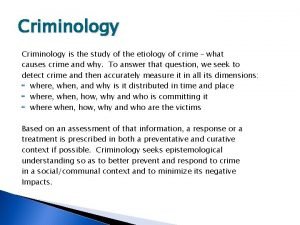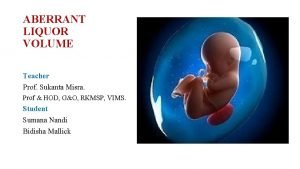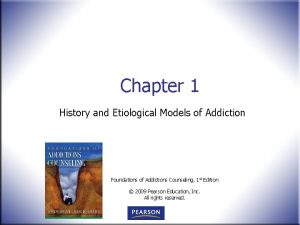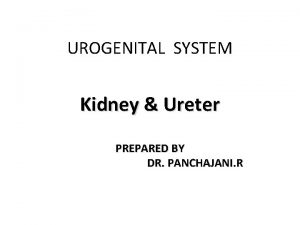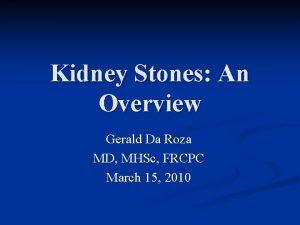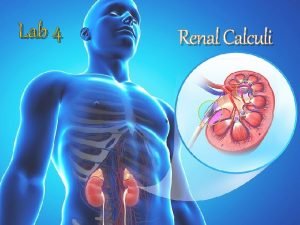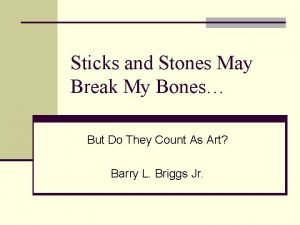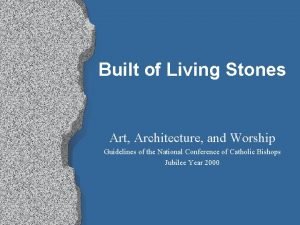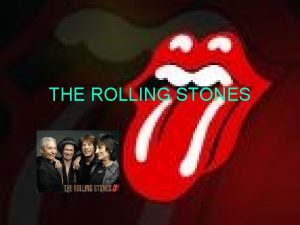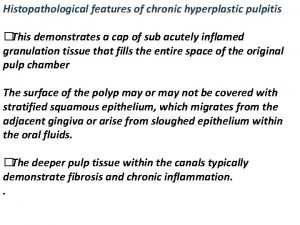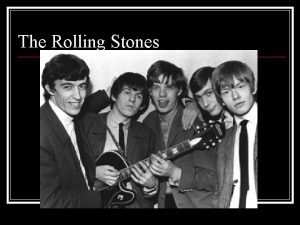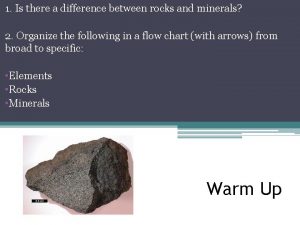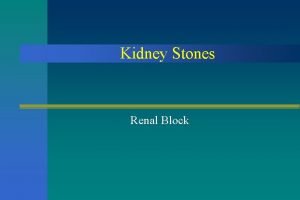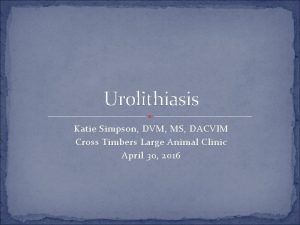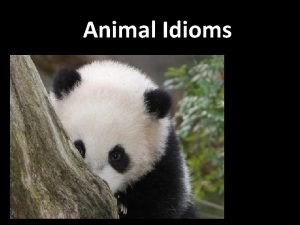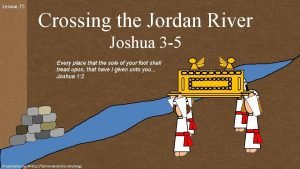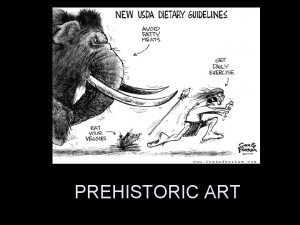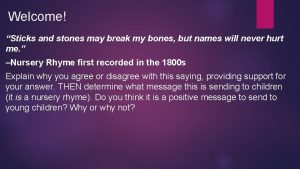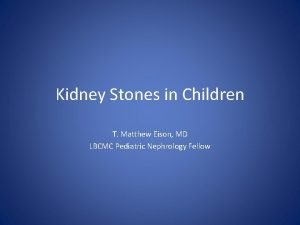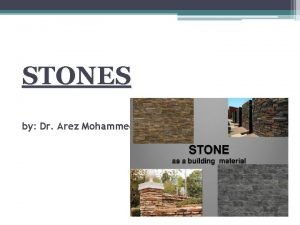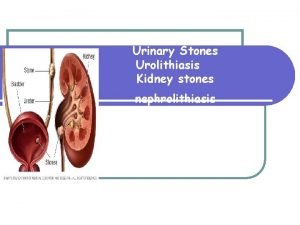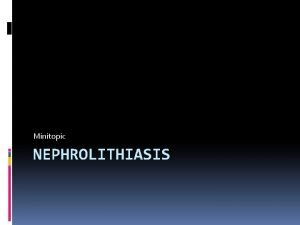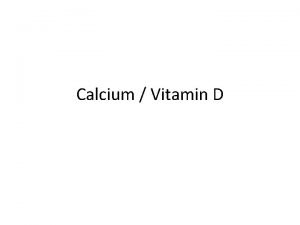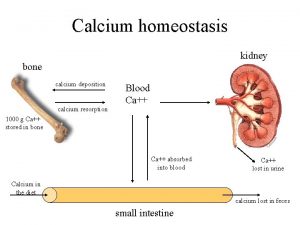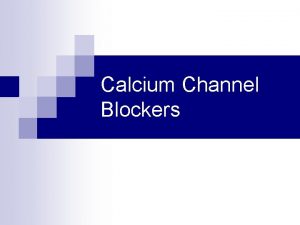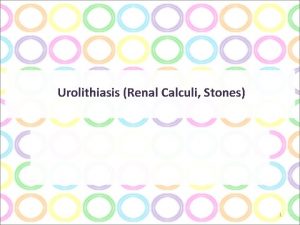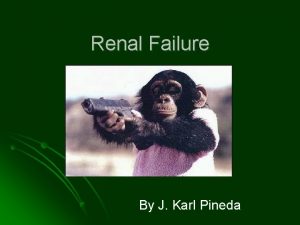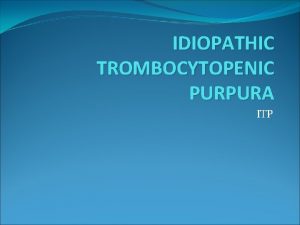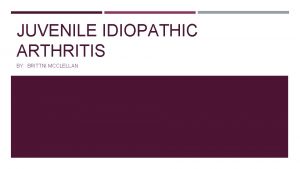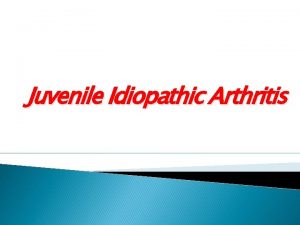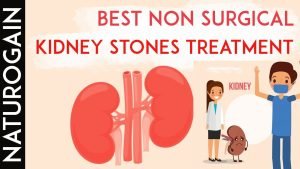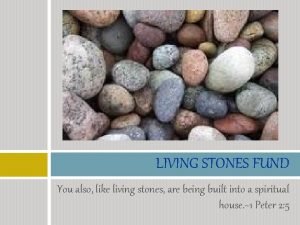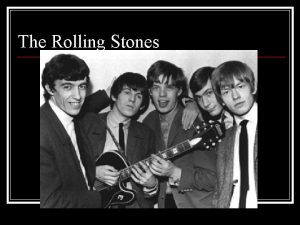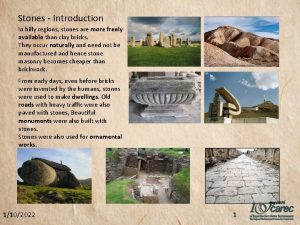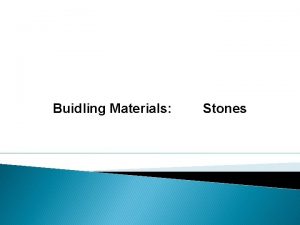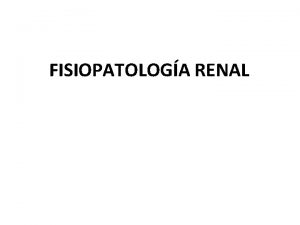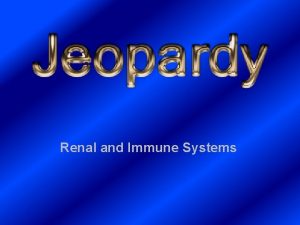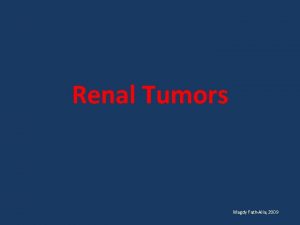RENAL STONES DR OHANG CHAUDHARI Etiology Idiopathic calcium




















































- Slides: 52

RENAL STONES DR. OHANG CHAUDHARI

Etiology • • • Idiopathic (calcium stone) Hypercalcaemic disorders Renal tubular syndromes Uric acid lithiasis Enzyme disorders Secondary urolithiasis

Idiopathic • Unexplained hypercalciuria with normal serum calcium level • 70% of renal stone patients have this type • 1 ) renal type- more common in children 2) absorptive type- more common in adult

HYPERCALCAEMIC DISORDERS • Parathyroid adenoma, chief cell hyperplasia • Overproduction of parathormone • Increased reabsorption of calcium from intestine, and renal tubules, &bone resorption • ( primary hyperparathyroidism)

Prolonged immobilisation • Lead to bone resorption • Hypercalcaemia, hypercalciuria • As immobility induces osteoclast mediated bone resorption

Milk alkali syndrome • Increased consumption of calcium, vitamine –D lead to hypercalcaemia, alkalosis, • Alkalosis compromise renal excretion of calcium • Other sarcoidosis

RENAL TUBULAR SYNDROME • Renal tubular acidosis • Cystinuria • Uric acid lithiasis

RTA • RTA type 1 associated with renal stone • Due to hypercalciuria & low urinary citrate excretion • Stones composed of calcium phosphate

cystinuria • Autosomal recessive disorder • Defect in amino acid transport in GIT & renal tubules. . cystine, lysine, arginine, ornithine • Increased excretion of such amino acid in urine • Cystine stones – multiple, very hard, radio opaque • Family members should be screened for it

Uric acid lithiasis • 5 -10% of renal stones • Uric acid is end product of purine metabolism • Who take exessive purine content food will excrete more uric acid in urine • Uric acid remains undissociated and insoluble at PH <5. 5 • Low urine volume contribute to uric acid stone formation

Uric acid stone • Inflammatory bowel disease, ileostomy lead to less urine formation • Uric acid stones are hard , smooth, multiple faceted • Pure uric acid stones are RADIOLUCENT but they look radio-opaque due to little bit presence of calcium

ENZYME DISORDERS • PRIMARY HYPEROXALURIA • XANTHINURIA • 2, 8 -DIHYDROADENURIA

PRIMARY HYPEROXALURIA • • • Autosomal recessive disorder Increased production of OXALATE Results in nephrocalcinosis Calcium oxalate stone Common in children

SECONDARY UROLITHIASIS • SECONDARY HYPEROXALURIA • DIETARY EXCESS- spinach, tea, coco, chocolate, peper increases urinary oxalate • INFECTION- urease producing organismproteus, pseudomonas, staphylococus,

infection • Bacteria breakdown urea to produce ammonia and co 2 • Urine becomes alkaline, , promote formation of STRUVITE STONE ( magnessium ammonium phoshphate) • Grown to form STAGHORN CALCULI

OTHER OBSTRUCTION STASIS MEDULARY SPONGE KIDNEY URINARY DIVERSION-(infection acidosis stasis) DRUGS: acetazolemide, allopurinol, thiazide diuretics • Less water intake • Sedentary life style • • •

TYPES • OXALATE STONES- (75%) also known as mulberry stones, brown in color having sharp projections • PHOSPHATE STONES (15%)-in infected urine, smooth & white in color, in alkaline urine filled in major calyces , taking shape of it. ( STAGHORN CALCULUS), large size, radio opaque • URIC ACID STONES –smooth, hard, yellow, multiple, radilolucent • CYSTINE STONES- cystinuria patient, very hard stone, attains large size

TYPES • XANTHINE STONE • STRUVITE STONE • INDIGO STONE

Calcium Oxalate stone

Stag horn stone

Stag horn

Struvite stone


CLINICAL FEATURES • PAIN- pain at renal angle, and in lumbar region - radiating to groin and testis -pain worsen on movement • VOMITING- due to pylorospasm • Hematuria • Pyuria • Fever • Burning micturition

Clinical sign • Tenderness in renal angle • Mass in hypochondrium or lumbar due to hydronephrosis which moves with respirations that is bimanually palpable ballotable soft smooth • May present with renal failure due to out flow obstruction

investigations • • • CBC RFT ESR S. CALCIUM BLOOD UREA, URIC ACID PTH LEVEL

INVESTIGATIONS • • • URINE – CALCIUM, CYSTINE, URIC ACID, MICRO PLAIN X RAY KUB IVP USG CECT RENAL SCAN

MANAGEMENT • CONSERVATIVE • SURGICAL

CONSERVATIVE • • If stone size < 8 mm Plenty of liquid orally Intravenous furosemide Anti spasmodic drugs

surgical • • If size > 8 mm PCNL ESWL OPEN SURGERIES - PYELOLITHOTOMY -NEPHROLITHOTOMY -PARTIAL NEPHRECTOMY

ESWL • Endoscopic shock wave lithotripsy • Piezo-electric or electromagnetic shock waves passed on stone through water bath or water cushion • Stone location confirmed by C-arm • 2 shocks per second • 1000 -4000 shocks required for each stone • Fragmented stone come out in urine

ESWL TABLE

ESWL

C ARM


WITH FLUOROSCOPY

ESWL ADVANTAGE • • • No anesthesia needed Can be done as OPD procedure , 2. 5 cm size stone can break very well Hard stones can easily eliminated Can perform multiple times as it is non invasive

COMPLICATIONS • RENAL HEMATOMA • HEMATURIA • FRAGMENTED STONE RETAINED IN URETER

CONTRAINDICATIONS • • PREGNANCY BLEEDING DISORDERS PATIENTS WITH ABDOMINAL ANEURYSM SEPSIS & RENAL FAILURE

PCNL • Per cutaneous nephrolithotomy • stones - > 2. 5 cm - multiple stones - stones not responding to ESWL • Cystoscopy is done and ureteric stent is placed • Renal pelvicalyceal system identified under C-ARM guidance

PCNL Through kidney , calyx and pelvis approached Will pass guide wire after needle puncture By using Graduated dilator track is widen NEPHROSCOPE is passed Will break stone by laser holmium, ultrasonic or electrohydraulic lithotripser • Size- 5 mm, 10 mm , 15 mm • • •

NEPHROSCOPE



COMPLICATIONS • HAEMORRHAGE • PERFORATION OF COLLECTING DUCTS • INJURY TO PLEURA, COLON

PYELOLITHOTOMY • • Stone in extra renal pelvis Posterior subcostal incision Remove 12 th RIB Open renal pelvis Remove stone Put DJ stent Put drain closure

EXTENDED PYELOLITHOTOMY • In case of intra renal pelvis • Incision on HILUM between pelvis & kidney over renal sinus

NEPHROLITHOTOMY • INCISION OVER BRODEL”S LINE • ON MOST CONVEX SURFACE OVER POSTERIOR PART • STONE REMOVED

NEPHROPYELOLITHOTOMY • INCISION OVER KIDNEY as well as on PELVIS • In case of STAGHORN STONE

PARTIAL NEPHRECTOMY • • • Multiple stones occupying in ONE POLE Usually lower Damage to that calyx Remove half kidney If not removed – can encourage further stone formation later

other • Bench surgery- kidney removed temporarily in ice pack, replaced in RIF • Coagulum pyelolithotomy • Anatrophic pyelolithotomy • Nephrectomy

THANK YOU.
 Ira pré renal renal e pós renal
Ira pré renal renal e pós renal Ira pré renal renal e pós renal
Ira pré renal renal e pós renal Bogʻlovchisiz qoʻshma gaplar
Bogʻlovchisiz qoʻshma gaplar Pragya chaudhari
Pragya chaudhari Peritubular capillaries and vasa recta difference
Peritubular capillaries and vasa recta difference Pediatric surgery
Pediatric surgery Idiopathic peripheral neuropathy
Idiopathic peripheral neuropathy Idiopathic hirsutism
Idiopathic hirsutism Idiopathic oat
Idiopathic oat Etiology
Etiology Etiology synonym
Etiology synonym Etiology of bronchial asthma
Etiology of bronchial asthma Pes statment
Pes statment Definition of periradicular disease
Definition of periradicular disease Etiology in criminology
Etiology in criminology Conclusion of malaria
Conclusion of malaria Etiology of appendectomy
Etiology of appendectomy Etiology
Etiology Potter face oligohydramnios
Potter face oligohydramnios Multicausal model of addiction
Multicausal model of addiction Mantoux test
Mantoux test Sucrose chelation theory
Sucrose chelation theory Circling back synonym
Circling back synonym Etiology of cerebrovascular disease
Etiology of cerebrovascular disease Asthma grades
Asthma grades Pathophysiology of kidney stones
Pathophysiology of kidney stones Sticks and stones origin
Sticks and stones origin Gerald da roza
Gerald da roza Emily wants to buy turquoise stones
Emily wants to buy turquoise stones Large monuments created from huge stone slabs
Large monuments created from huge stone slabs Odowa stones
Odowa stones What does kidney stones look like
What does kidney stones look like Stepping stones portsmouth ohio
Stepping stones portsmouth ohio Chris drury medicine wheel
Chris drury medicine wheel Built of living stones
Built of living stones The rolling stones člani
The rolling stones člani Pulp stones
Pulp stones The rolling stones origin
The rolling stones origin Difference between rocks and stones
Difference between rocks and stones Allusions in the lottery
Allusions in the lottery Calcium phosphate calculi
Calcium phosphate calculi Magnesium ammonium phosphate stones
Magnesium ammonium phosphate stones Killing 2 stones with 1 bird
Killing 2 stones with 1 bird Stepping stones to glory cartoon analysis
Stepping stones to glory cartoon analysis 75
75 Stepping stones triple p
Stepping stones triple p Lamp with ibex design
Lamp with ibex design Nursery rhyme sticks and stones
Nursery rhyme sticks and stones Sufi proverb in the desert there is no sign
Sufi proverb in the desert there is no sign Coffin shaped kidney stones
Coffin shaped kidney stones Series in sigma notation
Series in sigma notation Stepping stones to glory cartoon analysis
Stepping stones to glory cartoon analysis Collective nouns of stamp
Collective nouns of stamp


